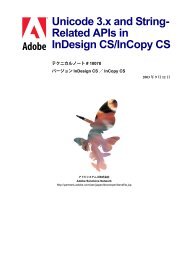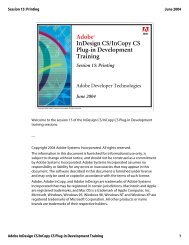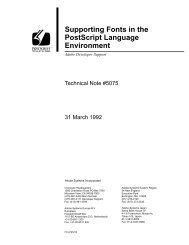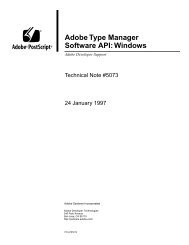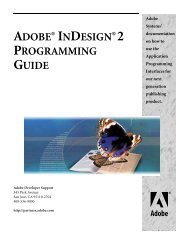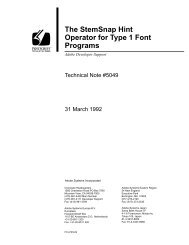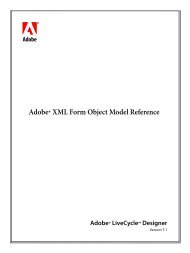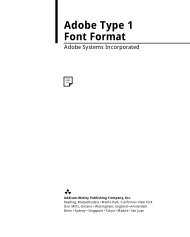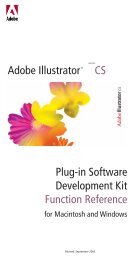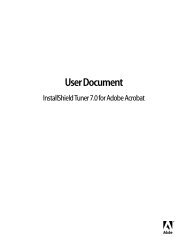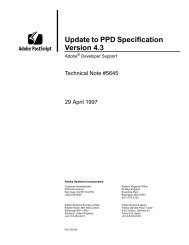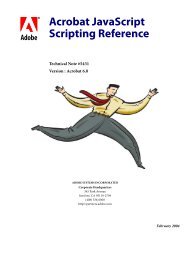Extensible Metadata Platform (XMP) Specification - Adobe Partners
Extensible Metadata Platform (XMP) Specification - Adobe Partners
Extensible Metadata Platform (XMP) Specification - Adobe Partners
You also want an ePaper? Increase the reach of your titles
YUMPU automatically turns print PDFs into web optimized ePapers that Google loves.
2<br />
<strong>XMP</strong> Data Model<br />
Schemas and Namespaces<br />
Moby Dick<br />
Author<br />
Date Written<br />
"Herman Melville"<br />
"1851"<br />
In the diagrams that illustrate the data model in this chapter, the top or root of the metadata tree<br />
is the resource—that is, the document or component to which the metadata applies.<br />
NOTE: The top level nodes in these illustrations have names simply for the sake of clarity for<br />
the reader. Within the <strong>XMP</strong> data model the resource need not have a formal name.<br />
NOTE: All property, structure field, and qualifier names in <strong>XMP</strong> must be legal XML qualified<br />
names. That is, they must be well formed XML names and in an XML namespace.<br />
IMPORTANT:<br />
To work properly with RDF, all XML namespaceURIs used in <strong>XMP</strong> must be<br />
terminated with "/" or "#". See , “Namespace termination” on page 29 for<br />
details.<br />
Schemas and Namespaces<br />
An <strong>XMP</strong> Schema is a set of top level property names in a common XML namespace, along<br />
with data type and descriptive information. Typically, an <strong>XMP</strong> schema contains properties that<br />
are relevant for particular types of documents or for certain stages of a workflow. Chapter 4,<br />
“<strong>XMP</strong> Schemas”, defines a set of standard metadata schemas and explains how to define new<br />
schemas.<br />
NOTE: The term “<strong>XMP</strong> Schema” used here to clearly distinguish this concept from other uses<br />
of the term “schema”, and notably from the W3C XML Schema language. An <strong>XMP</strong><br />
Schema is typically less formal, defined by documentation instead of a machine<br />
readable schema file.<br />
An <strong>XMP</strong> Schema is identified by its XML namespace URI. The use of namespaces avoids<br />
conflict between properties in different schemas that have the same name but different<br />
meanings. For example, two independently designed schemas might have a Creator property:<br />
in one, it might mean the person who created a resource; in another, the application used to<br />
create the resource.<br />
The namespace URI for an <strong>XMP</strong> Schema must obey the rules for XML 1.1 namespaces. In<br />
addition, to operate well with RDF it must end with a ‘/’ or ‘#’ character. (See “Namespace<br />
URI termination” on page 29) The URI might or might not actually locate a resource such as a<br />
web page. <strong>XMP</strong> places no significance on the scheme or components of the namespace URI.<br />
14 September 2005 <strong>XMP</strong> <strong>Specification</strong>





